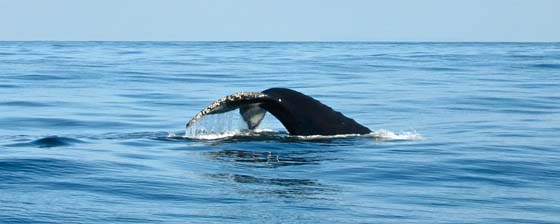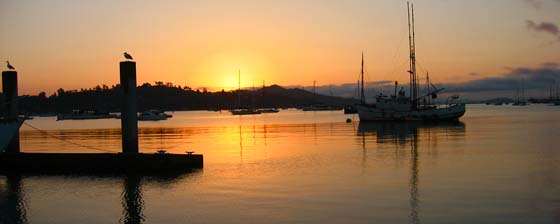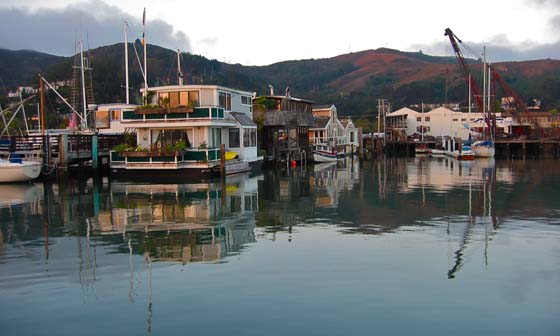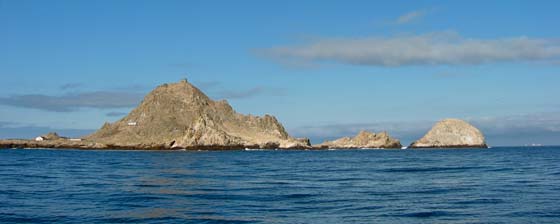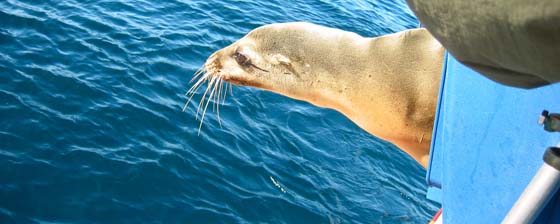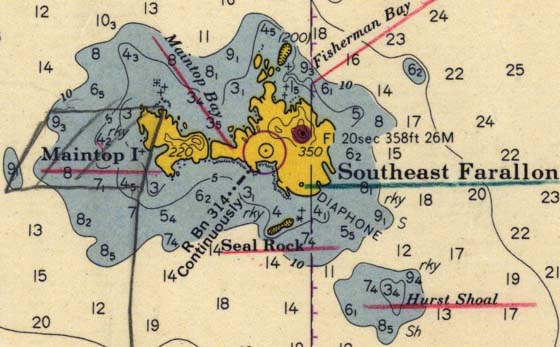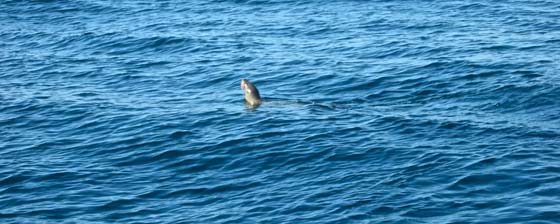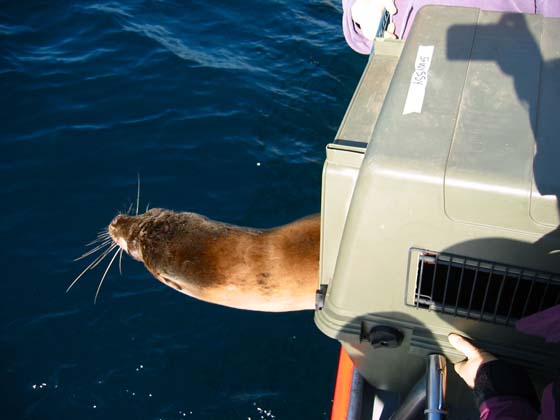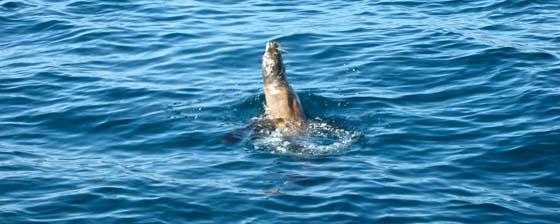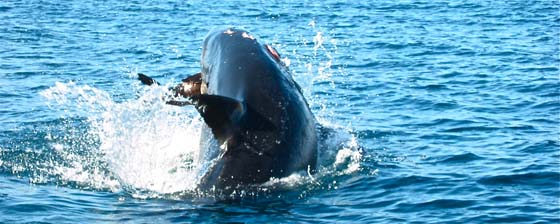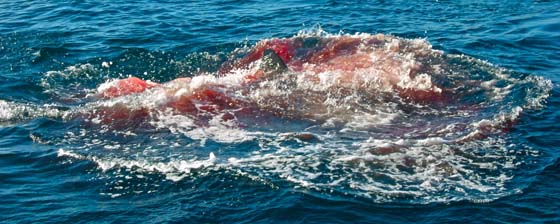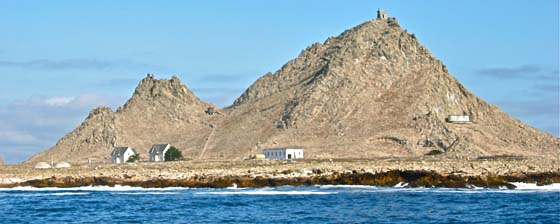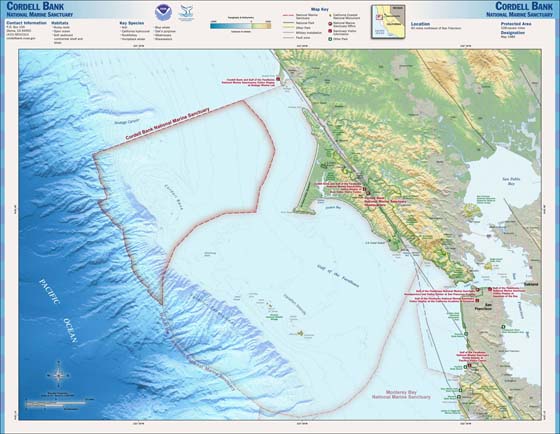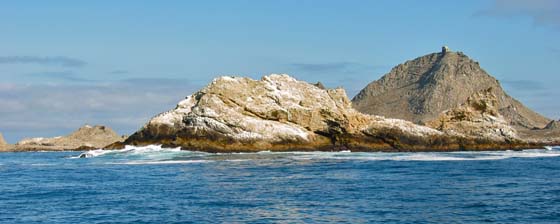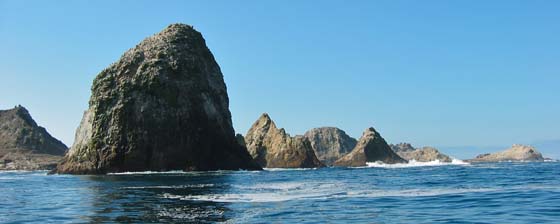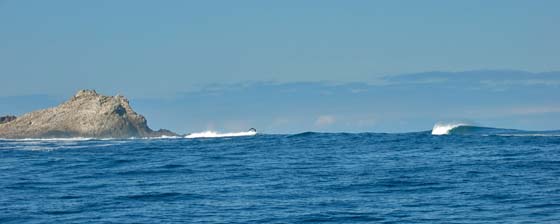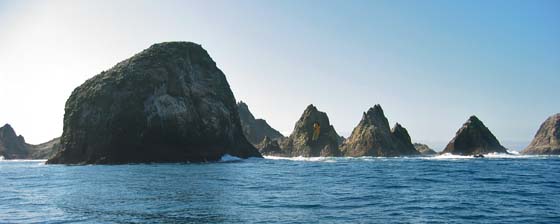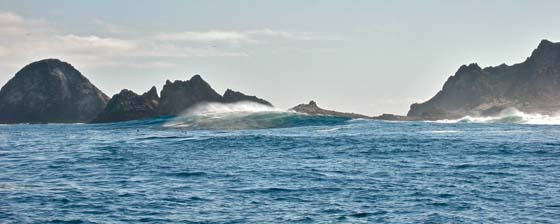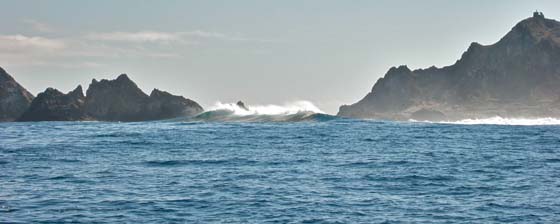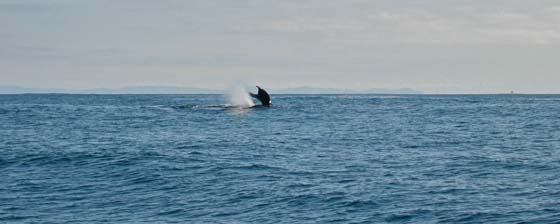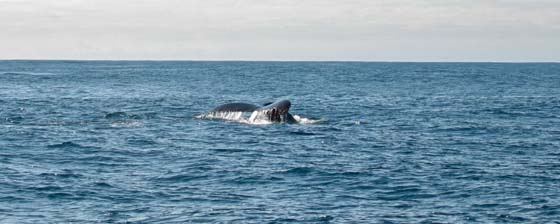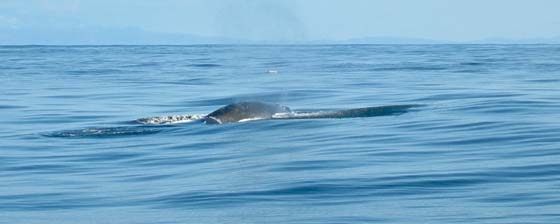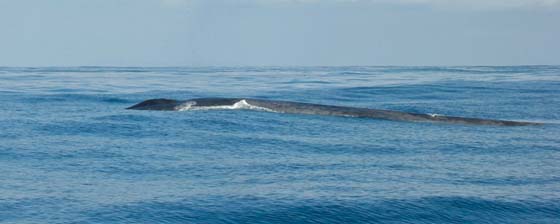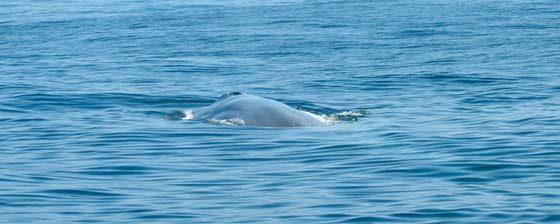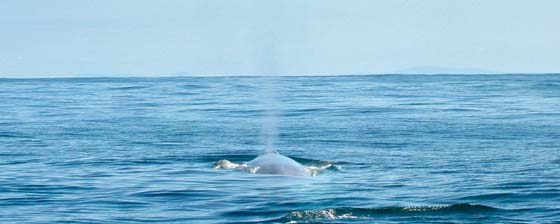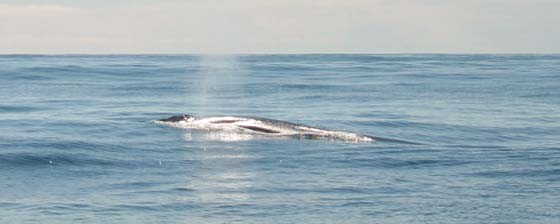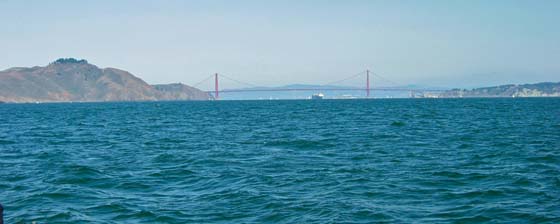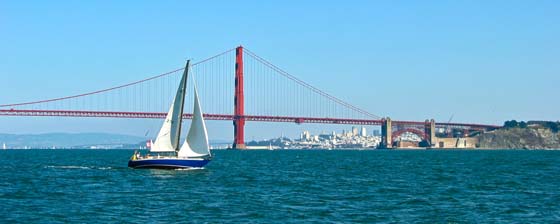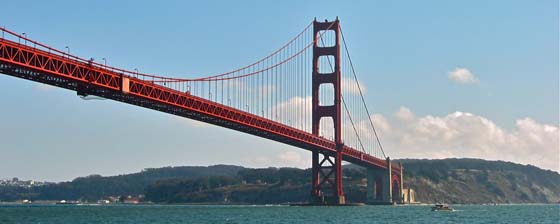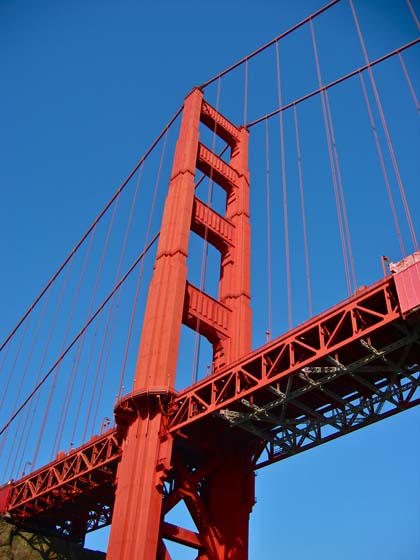Whale Watching at the Farallon Islands, California
Date: September 29th 2002
Duration: one day
Distance: 20 miles
Transportation: boat
Viewed: 30189 times
Comments: 12
Last year we started sailing on San Francisco Bay. We had some wonderful sunny days in spring passing through Raccoon Strait between Tiburon and Angel Island, turning around Alcatraz, sailing under the mythical Golden Gate and Bay Bridge and meeting in the wild, the pinnipeds we love so much. We often see California sea lions or harbor seals swimming next to the hull of our boat.
We could not tell the difference between them one year ago. It has become an easy task since we started volunteering at The Marine Mammal Center in Sausalito in January 2002. There, people work hard to give a second chance to marine mammals in distress.
Today, Sunday September 29th 2002, our adventure will be a little bit different. We are going to trade our rental twenty-two foot sailboat for a motorboat, the Salty Lady. A bunch of volunteers and relatives of the center is chartering her to go off shore, far outside the bay, to the Farallon Islands to watch far much bigger mammals than our usual pinnipeds, the whales.
Two days before, during our weekly meeting of the Friday Night Crew at the Mammal Center, we discovered that a last minute decision had been made to release two sea lions during this trip, Edog and Swissy. It will be the first release we participate in, since we joined The Marine Mammal Center. Dozens and dozens of elephant seals, harbor seals and sea lions have been released in the wild in the past months but we have never been able to join the team for a release. This is so unexpected that we feel very fortunate.
The decision to release offshore at the Farallon Islands is made when animals have become way too accustomed to humans and are not afraid of them anymore. The goal is to have them readapt to their wild environment.
This is a prime location for this purpose as human presence is limited.
Our naturalist is Doreen Moser. Since 1995, Doreen has been the Assistant Director of Education with The Marine Mammal Center. At the center, she teaches marine mammal science to students and volunteers. Additionally, she has been a naturalist with Oceanic Society since 1991. She leads natural history trips locally, as well as Baja California, Vancouver, and the Galapagos Islands.
We leave the dock at high tide. We are a few minutes away from the slack and the bay is totally calm with almost no current. For the first time ever, we leave the Golden Gate behind us. We are used to sail on rental boats but due to insurance policies we have never been able to leave the bay.
The entrance of the bay is so quiet. No one could guess that this part is known by sailers as the potato patch because of the confused waves found there during tides. We leave Point Bonita on starboard and here we are now on the wild Pacific Ocean.
This trip was planned two months ago. We hope to see whales but don't really expect them, as it seems we cannot in advance agree of a rendezvous point with these giant mammals. Our level of expectations is quite low, a good trick to never be disappointed.
We simply hope to have a nice ride on the ocean and discover the Farallon Islands. Whatever happens on top of that is gladly welcome.
A short distance from Point Bonita we see many pacific harbor porpoises jumping off the water on starboard and a few minutes later a few pacific white-sided dolphins on port.
We are very lucky with the weather today. The summer fog period is almost over and in September and October we have a radical change in the wind. Blowing from the West all summer long, it is now calming down, getting warmer and comes sometimes more from the south or east. We get beautiful warm days with a clear blue sky. Locals call this period the Indian Summer.
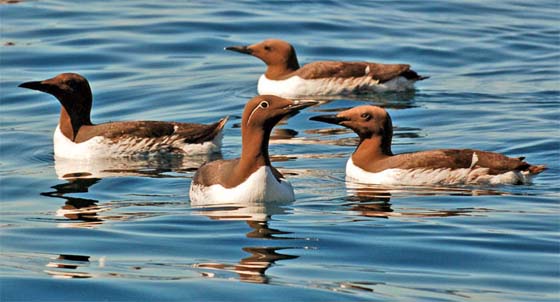
Permission to redistribute under the GNU Free Documentation License
Source is Wikimedia Commons
The Farallon Islands are located about 26 miles west of the Golden Gate Bridge. It is the largest single continental seabird breeding colony in the Pacific south of Alaska, supporting 29% of California's breeding seabird population. Twelve nesting species, including western gulls, Brandt's cormorant, murres, auklets, tufted puffins and ashy storm petrel are found there. A variety of migrating land birds, including hummingbirds and mockingbirds, frequent the island from time to time. Five pinniped species can now be found at the Farallones, comprising northern elephant seals, harbor seals, California sea lions, Steller's sea lions and Northern fur seals (the latter species being now extremely rare).
Russian seal hunters severely impacted the pinniped colonies at the Farallones during the 1800's, and indeed elephant seals only began to re-colonise the islands in the 1960' and 70's after an absence of over 100 years, but have now been breeding there for over 15 years.
Many cetaceans visit the islands, such as Pacific gray whales, humpbacks, blues, and harbor porpoises. Because this area has such abundant sea life, it was designated a marine sanctuary in 1981.
A combination of oceanic conditions and undersea topography creates an amazingly productive marine environment. The ground of the deep ocean is covered of nutrients like decaying carcasses or dead animals, scats and various sediments.
The islands are at the edge of the continental margin. The ocean floor suddenly drops from a few dozens to hundreds of meters like a giant abyss.
A few miles to the west the seafloor plummets to depths of 6,000 feet/1800 meters.
The upwelling of rich, deep-ocean waters stimulates the growth of plankton. Millions of tiny reddish fifteen to twenty millimeters long shrimps named krill come along and eat this plankton.
Fishes, birds and whales are great consumers of this krill. Krill are a major food source for salmon too. Krill pigments give salmon flesh its characteristic pink color. The main reason humpback and blue whales visit the place in the summer is to fatten up on krill to prepare for the rigors of the coming year.
The pinnipeds that are breeding on the islands are the main fishes' predators. Top predators like sharks feed on seals and sea lions. Sharks are then regulated by the top predator of the ocean, the killer whale that feeds not only on these fishes but also on marine mammals.
Many of the marine mammals found here are endangered or threatened and the protection of the surrounding oceanic habitat is helping their numbers to recover.
Permission to redistribute under the GNU Free Documentation License
Source is MarEco via Wikimedia Commons
It is time for Edog and Swissy to go back to the wild. The islands are a big rock with no place to dock to release on shore. We are one hundred meters from the shore where we can see a bunch of sea lions.
The first one to be released is Edog. The small carrier is put on the port side with the door opened.
Edog is now in the face of the unknown and it takes this guy a few seconds to jump of the boat and dive in the ocean.
Public domain image
Source is NOAA (the U.S. National Oceanic and Atmospheric Administration)
There he comes back to the surface, swimming and porpoising. By two times I miss a nice picture of Edog and hope having a nice one with the other sea lion. Everybody is so happy. After a few circles in the water, Edog disappears hopefully to get back to the groups of pinnipeds we see on the rocks. Doreen tells us that, one day, a released sea lion was found running on Ocean Beach in San Francisco twenty-four hours later. These guys are amazing swimmers.
It is now time for Swissy to be released. After a short hesitation she dives in the blue.
Getting ready for the next shot
Then, she leaps out and dives again. I get my camera prepared for the next jump when she comes back. I see something arriving and I focus on the surface. Suddenly, coming out of the blue, something really huge is tearing apart the peaceful surface of the ocean. As I snap my first shot I don't really understand what I see in my camera, less than fifteen feet away from the hull. It's a colossal animal. Everything happens in seconds and different ideas come to my mind at the same time. I first think it is a killer whale thinking "Cool ! I finally see a free one", then I notice there is no white spot on this beast. I understand then it is an eighteen-foot great white shark. Screams and cries on board make me finally realize what is going on. The shark just preyed upon the little Swissy. The water gets quickly bloody as this giant fish finishes his breakfast. In less than a minute the shark disappears and we witness a little bit away from the boat a second white shark attack close to a group of sea lions swimming next to the shore.
Wow! I was just a few feet away from the attack. I felt like Roy Sheider for a second thinking that we needed a bigger boat.
That was the hell of a big fish and I was leaning overboard really freaking close. As I found out after the facts the image's metadata mention a subject distance of 2.7 meters, half the length the shark itself.
For the crew, this was really a shocking moment. As everybody is really sad about what just happened, Doreen handles the situation with a great calm, cheering up everybody, focusing on the extraordinary event we are witnessing. Saying that in years she has never seen anything like this before, she is insisting on the spectacular example of the brutality of nature that is rarely seen. I deeply admire what she did to keep the team all together, reminding each and everyone of us the importance of what we do all year long at the center, and aiming for what comes next during this day that is just beginning. These islands have been a release site since 1977 with almost a hundred releases and this was the first time ever such a thing has been witnessed. One day, up to seven animals have been released at the same spot. It looks like the shark was at the right spot at the right moment for its breakfast. This guy had to eat something today, and somehow, Swissy saved the life of another sea lion.
We know anyway that sharks are a natural predator of seals and sea lions, and when we release animals back to their own environment there is always the possibility that they may not survive. We were simply not ready to see it, and to see it that close, that brutal and that soon after the release.
Public domain image
Source is NOAA, National Marine Sanctuaries
As expected, the North shore is an amazing surf spot. The swell is not that big today, but an amazing wave is breaking in Maintop Bay. On a day like this, it is pretty flat on the spot of Mavericks in Half Moon Bay, but here, a ten-foot wave is surging every two minutes. After what we just saw I understand why there is no surfer on this perfect wave.
We are now on the north of the islands and as we see this wave from behind, suddenly two Humpback Whales come out and blow. Salty Lady is slowing down for a minute. We are very close to them. We see further to the West many white clouds indicating the presence of whales. A short time later we are in the middle of a bunch of whales. The captain turns off the engine and we can now hear the powerful sound of the whale blowing out next to us. They are everywhere around us.
Doreen tells us that when we breathe out, only twenty percent of our lungs are thrown out. We are very inefficient but we don't care because we can breathe whenever we want. Whales are throwing out ninety percent of the volume of theirs lungs.
They come out of the water, breathe in and out two or three times and then dive back into the ocean. We are the privileged spectators of this gigantic aquatic ballet. Too far away from us to see clearly or make a photograph with my small camera, we see a whale jumping out of the ocean as we often see in documentaries. Wow! The splash zone might be impressive around there.
Further more to the West, we notice whales blowing really high. Thirty feet in the air is a typical blow of a blue whale.
Salty Lady moves closer to them and turns off the engine. Doreen stands up on a bench and, in a very agitated and passionate way, delivers a flow of amazing information: "They can communicate with each other over hundreds of miles, they are the length of three school buses, their heart is as large as a Volkswagen beetle, they can consume 4 tons of food each day, the adults weigh about one ton per foot, a nursing mother produces over 50 gallons of milk a day, the calf can gain over 240 pounds a day - that's over 10 pounds an hour. You have here, before your eyes the biggest mammal on earth, the blue whale".
After enjoying this natural show for quite a while, it is time to head back to Sausalito.
During the trip back home, many more white-sided dolphins and porpoises cross our path for the greatest pleasure of our eyes.
At the dock, as we step off Salty Lady, we have the feeling of having been the visitors of a parallel world where everything is gigantic. These unforgettable images will be stamped in our minds forever, from the early morning release to the gigantic whales. We think that we definitely have to find a way to go sailing there next summer.
Sharks gotta eat too
Dreampusher,
What an amazing opportunity! I am extremely jealous! ( love your blog btw) I live in Massachusetts. An amazing book I just finished reading is " The Devils Teeth" by Susan Casey. It is how I first heard about the islands, now I am obsessed! It is my dream to someday be able to even just take a boat trip near the islands! In the book, they actually mention the whole seal release fiasco!
It looks like you released Edog and Swissy almost due east of Shrubrickk point. I think your issues here was time of year. Fall time there you and asking to be attacked. How far off the island did the attack occur?
Hi Sean,
That's the hell of a nice comment. Thanks a lot.
You were looking for surf spots at the Farallon Islands??
Out of curiosity? Or to actually ride that wave on a surf board?
I was told that for many years a free diver was swimming under water with the sharks and never had a problem.
Surfing might be a different game.
If you go and surf there, I'd love to see your photos or read your story. From what I recall the wave was huge and spooky beautiful.
What an incredible blog. Absolutely amazing! I stumbled upon this site when i began a search on the potential of 'surf spots' on the Farralon Islands. And as reported on your site, their is Surf on the Farralons! It must have truly been surreal to witness so many whales. Incredible creatures that have so much to teach humans. Thank you for sharing your experiences.
Cheers
Hello Stephen,
I don't have any info or photo concerning this. You might want to take a look at the website marinnostalgia.org
It is a community website where people can post photos of Marin County from different periods
The sixties sounds right up their alley
Hope that helps
Dear Dreampusher Publishers and others,
I am searching for old Gate 5 boat scene photos as Gate 5 was back in the 1960's. I would be using these on my Hubpage at http://hubpages.com/hub/Room-Rental-Finder. My story about having lived at the old Gate 5 is farther down that page.
Any photos of the old Gate 5 depicting the worn, torn weathered Gate 5 houseboats would be appreciated. I would link each photograph provided back back to Dreampusher.com, this page. This is also a general request to people of the sixties that may have photos of the old Gate 5 and Gate 5 daily houseboat living.
Thanks for any help that you might be.
Sincerely,
Stephen Bass
Hubpages writer
email: usa.englishteacher@yahoo.com
The Devil's Teeth, wow, thanks for the information Edward. It reads
'A week afterward, back on the mainland, one of the would-be samaritans sent Peter some pictures of the sea lion's demise. By blind luck the shutter had gone off at the exact moment of the hit, and as far as attack photos went they were the best he'd ever seen.
Later I saw the pictures myself and it's true, they are spectacular. A two-ton, sixteen-foot male shark named Gouge is heaving himself out of the water only a few feet away from the camera.'
I wonder who that would-be samaritan was.
I remember being asked to send out the photos but I can't remember the name of the person who asked me to.
Great post Edward, thanks for reading and sharing.
http://books.google.com/books?id=GbPeRKhxJ08C&pg=PA91&lpg=PA91&dq=%22the+devil's+teeth%22+swissy&source=bl&ots=LAd8J19g37&sig=IzWrPqBXgu6LpnBMxC3ogXphXZc&hl=en&ei=dOnCTOaMDISBlAeEhewD&sa=X&oi=book_result&ct=result&resnum=1&ved=0CBMQ6AEwAA#v=onepage&q&f=false
They Talk about Swissy in the Book "The Devils Teeth"
Hi Edward,
Interesting information, I didn't know about that one.
Well, it was 7 am and the big guy was hungry and had to eat something ;-)
Bad timing, that's all.
Tough to say for sure about Edog, but it looked like he had aimed at the island towards a bunch of other sea lions. So yes, it seemed that he made it.
Thanks for posting
The shark that took Swissy was a well known by the reseachers at the island. His name is Gouge and from what they say he is one of the most aggesive Whites they have seen. Did Edog make it or not?
That shark is not very nice for eating that seal.

